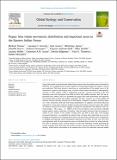Files in this item
Pygmy blue whale movement, distribution and important areas in the Eastern Indian Ocean
Item metadata
| dc.contributor.author | Thums, Michele | |
| dc.contributor.author | Ferreira, Luciana | |
| dc.contributor.author | Jenner, Curt | |
| dc.contributor.author | Jenner, Micheline | |
| dc.contributor.author | Harris, Danielle | |
| dc.contributor.author | Davenport, Andrew | |
| dc.contributor.author | Andrews-Goff, Virginia | |
| dc.contributor.author | Double, Mike | |
| dc.contributor.author | Möller, Luciana | |
| dc.contributor.author | Attard, Catherine R.M. | |
| dc.contributor.author | Bilgmann, Kerstin | |
| dc.contributor.author | Thomson, Paul | |
| dc.contributor.author | McCauley, Robert | |
| dc.date.accessioned | 2022-02-28T13:30:13Z | |
| dc.date.available | 2022-02-28T13:30:13Z | |
| dc.date.issued | 2022-06 | |
| dc.identifier | 277889237 | |
| dc.identifier | 8d6cea11-2c19-4674-b2b3-a06f4f577a23 | |
| dc.identifier | 000761018100003 | |
| dc.identifier | 85126146362 | |
| dc.identifier.citation | Thums , M , Ferreira , L , Jenner , C , Jenner , M , Harris , D , Davenport , A , Andrews-Goff , V , Double , M , Möller , L , Attard , C R M , Bilgmann , K , Thomson , P & McCauley , R 2022 , ' Pygmy blue whale movement, distribution and important areas in the Eastern Indian Ocean ' , Global Ecology and Conservation , vol. 35 , e02054 . https://doi.org/10.1016/j.gecco.2022.e02054 | en |
| dc.identifier.issn | 2351-9894 | |
| dc.identifier.other | RIS: urn:8EF14780EAA2DE30F6F6A391E8531567 | |
| dc.identifier.other | ORCID: /0000-0003-1447-1420/work/108508576 | |
| dc.identifier.uri | https://hdl.handle.net/10023/24960 | |
| dc.description | This study was conducted as part of AIMS’ North West Shoals to Shore Research Program (NWSSRP) and was supported by Santos as part of the company’s commitment to better understand Western Australia’s marine environment. Hydrophone pressure data from Ocean Bottom Seismometers (OBS) were provided by the CANPASS project, jointly funded by the National Natural Science Foundation of China (NSFC grants 91955210, 41625016), and the China Academy of Science (CAS program GJHZ1776). Instruments were provided by the Australian National instrument pool ANSIR (http://ansir.org.au/). ANSIR, OBS data was also made data available from the Geoscience Australia and Shell. Data was sourced from Australia’s Integrated Marine Observing System (IMOS). | en |
| dc.description.abstract | Pygmy blue whales in the South-east Indian Ocean migrate from the southern coast of Australia to Indonesia, with a significant part of their migration route passing through areas subject to oil and gas production. This study aimed at improving our understanding of the spatial extent of the distribution, migration and foraging areas, to better inform impact assessment of anthropogenic activities in these regions. Using a combination of passive acoustic monitoring of the NW Australian coast (46 instruments from 2006 to 2019) and satellite telemetry data (22 tag deployments from 2009 to 2021) we quantified the pygmy blue whale distribution and important areas during their northern and southern migration. We show extensive use of slope habitat off Western Australia and only minimal use of shelf habitat, compared to southern Australia where use of the continental shelf and shelf break predominates. In addition, movement behaviour estimated by a state-space model on satellite tag data showed that in general pygmy blue whales off Western Australia were mostly engaged in migration, interspersed with mostly relatively short periods (median = 28hours, range = 2 – 1080hours) of low move persistence (slow movement with high turning angles), which is indicative of foraging. Using the spatial overlap of time and number of whales in area analysis of the satellite tracking data (top 50% of grid cells) with foraging movement behaviour, we quantified the spatial extent of pygmy blue whale high use areas for foraging and migration. We compared these areas to the previously described areas of importance to foraging and migrating whales (Biologically Important Areas; BIAs). In some cases these had good agreement with the most important areas we calculated from our data, but others had only low (5%) to moderate (13%) overlap. Month was the most important variable predicting the number of pygmy blue whale units and number of singers (acting as indices of pygmy blue whale density). Whale density was highest in the southern part of the NW Australian coast and whales were present there between April-June, and November-December, a pattern also confirmed by the satellite tracking data. Available data indicated pygmy blue whales spent up to 124 days in Indonesian waters (34% of annual cycle). Since this area may also be the calving ground for this population, inter-jurisdictional management is necessary to ensure their full protection. | |
| dc.format.extent | 20 | |
| dc.format.extent | 12307747 | |
| dc.language.iso | eng | |
| dc.relation.ispartof | Global Ecology and Conservation | en |
| dc.subject | Migration | en |
| dc.subject | Foraging | en |
| dc.subject | Satellite telemetry | en |
| dc.subject | Passive acoustics | en |
| dc.subject | Biologically Important Areas | en |
| dc.subject | Ecologically Significant Areas | en |
| dc.subject | GC Oceanography | en |
| dc.subject | QH301 Biology | en |
| dc.subject | NDAS | en |
| dc.subject.lcc | GC | en |
| dc.subject.lcc | QH301 | en |
| dc.title | Pygmy blue whale movement, distribution and important areas in the Eastern Indian Ocean | en |
| dc.type | Journal article | en |
| dc.contributor.institution | University of St Andrews. School of Mathematics and Statistics | en |
| dc.contributor.institution | University of St Andrews. Sea Mammal Research Unit | en |
| dc.contributor.institution | University of St Andrews. Centre for Research into Ecological & Environmental Modelling | en |
| dc.identifier.doi | https://doi.org/10.1016/j.gecco.2022.e02054 | |
| dc.description.status | Peer reviewed | en |
This item appears in the following Collection(s)
Items in the St Andrews Research Repository are protected by copyright, with all rights reserved, unless otherwise indicated.

